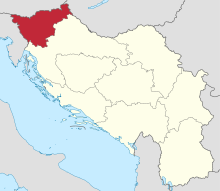Banschaft Drava
The Banschaft Drava or the Drava Banat ( Slovene. , Cyrillic Dravska banovina , Kyrill . Дравска бановина) was one of the nine banks or Banats of the Kingdom of Yugoslavia , which were formed on October 3, 1929. The capital, de facto provincial capital, was Ljubljana . The Banschaft roughly comprised today's Slovenia , excluding the coastal areas that Yugoslavia and Slovenia were granted after 1945. The bank got its name after the river Drava .
history
The Drau-Banat was created in 1929 with the reorganization of the Yugoslav state from the Kingdom of Serbs, Croats and Slovenes ("SHS State") to the Kingdom of Yugoslavia under Alexander I and covered 15,936 km². In contrast to the Bosniaks , Croats and Serbs , whose ethnic settlement area did not correspond to the borders of the banks (which was especially true for the Bosniaks, while Croatian politicians criticized that the borders of the banks favor the Serbian settlement area and thus the position of the Serbs), the Slovenes got a bank consisting of the former old Austrian crown land Krain , Lower Styria , as well as the parts of Lower Carinthia , which also fell to the SHS state in 1918 . Since its extent corresponded to the Slovene settlement area in the Kingdom of Yugoslavia, the Drava Banat was already considered the "Slovene Banat". With the establishment of the autonomous “Croatian Bank” in 1939, it was planned to divide Yugoslavia into three federal units, consisting of a Slovenian, a Croat and a Serbian bank. The Drau-Banat was supposed to become the “Slovenian Banat”. After the attack by the Hitler regime on the Kingdom of Yugoslavia and the capitulation of Yugoslavia in 1941, the Drau-Banat was divided between Nazi Germany, Mussolini's Italy and Horthy's Hungary. After the war in communist Yugoslavia, the Socialist Republic of Slovenia was founded as a federal republic of the Socialist Federal Republic of Yugoslavia instead of the Banschaft Drava .
population
The population of the Drava Banat of 1.04 million consisted almost entirely of Slovenes (92.3%). The largest minority were German speakers (3.9%), Serbo-Croatian spoke 1.7%, Hungarian 1.4%. With a share of 96.6% Catholics, the Drau-Banat was the strongest Catholic and with a share of 0.6% the weakest Orthodox administrative district (1921 census).
administration
As in all nine Banats, a governor appointed by the king, the Banus , stood at the head of the Drava Banschaft . At his side was a council of approximately two dozen members who were also appointed in matters of self-government in the Banschaft (banovina) .
Web links
Individual evidence
- ↑ a b Der Große Brockhaus, handbook in twenty volumes (Brockhaus Konversations-Lexikon, 15th edition) Vol. 9, Leipzig 1931, p. 497
-
↑ Wörsdörfer, Rolf: Krisenherd Adria 1915 - 1955. Construction and articulation of the national in the Italian-Yugoslav border area in the Google book search, Habil.-Schrift.Darmstadt, TU Darmstadt 2002, Verlag Schöningh, Paderborn-Wien 2004, p. 159 u . a. ISBN 3-506-70144-4 or
Arnold Suppan : Yugoslavia and Austria 1918-1938. Bilateral foreign policy in the European environment ( Memento of the original from January 28, 2015 in the Internet Archive ) Info: The archive link was automatically inserted and has not yet been checked. Please check the original and archive link according to the instructions and then remove this notice. , (Publications of the Austrian East and Southeast Europe Institute 14) Verlag für Geschichte u. Politics, Vienna 1996 p. 671 u. a. ISBN 3-486-56166-9
